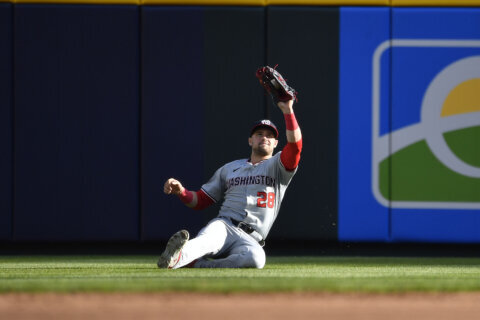WASHINGTON — There was plenty of discussion this year regarding the NHL’s playoff format and if it needs to be altered. The current playoff format was introduced in 2013-14 and sees the top three teams from each division earn a postseason berth, with the next two best teams in each conference earning wild card berths (regardless of division).
The top division champion plays the second wild card team (regardless of division), while the second division winner plays the top wild card team. The second and third place teams from each division play each other, rounding out the four first-round matchups in each conference.
When one division is considerably stronger than the other division in the same conference, it creates imbalance in the playoff seedings. That’s exactly what’s happened this year.
Take a look at the Eastern Conference entering play Thursday. The top four teams all reside in the Metropolitan Division, meaning that the eight teams that qualify for the conference quarterfinals would be matched up as follows under the current format (overall seeding in parentheses):
- Washington (1) vs. New York Islanders (8)
- Columbus (2) vs. Pittsburgh (3)
- New York Rangers (4) vs. Montreal (5) – with Canadiens owning home-ice advantage
- Ottawa (6) vs. Boston (7)
Years ago, the NHL seeded teams 1 through 15 in the Eastern and Western conferences, with division champions automatically earning the top two seeds and the playoffs following a 1 vs.8, 2 vs.7, 3 vs.6 and 4 vs.5 format.
It’s time for the NHL to again return to conference seedings, but in the proposal below, I’ve added a twist.
Earlier this season, Detroit Red Wings general manager Ken Holland suggested that the Stanley Cup Playoffs expand with the addition of a “play-in game” in each conference. MLB introduced a similar concept in 2012 with the creation of a best-of-one Wild Card Game.
With this in mind, I present the proposed playoff format below. At first this will seem extreme, but stay with me.
First, the NHL would return to conference seeding for postseason. Division champions get the first and second seeds. The big proposal here is to expand the playoffs with additional play-in games. For the sake of marketing, we’re calling them “Must-Win Games.” (Play-in-games have a negative connotation).
I’m proposing a 7-10 and an 8-9 game from each conference to be played on the Tuesday and Wednesday nights of the opening week of the postseason. The 7-10 games get played on the Tuesday; 8-9 games on Wednesday.
There are five key components to why I think this is an improvement:
- This may seem obvious, but you keep more teams and fan bases engaged in a playoff race down the stretch. If your team is in 11th or 12th place in the final few weeks of the season, there is still a chance to earn a berth in the Must-Win Game. More teams are therefore playing meaningful hockey down the stretch.
- You increase the value of finishing in the top six within the conference, because that guarantees a berth in the best-of-seven conference quarterfinals.
The biggest critique for expanding the playoffs or adding more teams is that you devalue the 82-game regular season. Under this format, the regular season is actually given greater value, with an added reward for finishing in the top six of your conference. Suddenly, finishing in the top eight isn’t worth the same as finishing in the top six and guaranteeing your spot in the conference quarterfinals.
This will also create additional races down the stretch. Not only will there be a race to finish in the top 10 in the conference, but now there will also be a race to finish within the top six. This could be critical during the final week of the season for the teams that are potentially in the 5,6,7,8 positions. It essentially creates a race within a race.
- There is a potentially greater reward for winning the division and finishing with the No. 1 or No. 2 seed in the conference. Say for example, the No. 10 beats the No. 7 in the Must-Win Game. This would mean that the No. 1 seed would face the No. 10 in the conference quarterfinals, as opposed to facing the No. 8 seed under the old format.
While a 10th-seeded team could still upset a top-seed in a best-of-seven series, the thought here is that the top seed in the conference should have an easier time with a No. 10 as opposed to a No. 8. They’ll also have the benefit of added rest that the team that advances will not.
Again, upsets can still happen and any NHL team can take out another NHL team in a best-of-seven. But again, going based on the standings, there should be a greater likelihood for a No. 1 seed to defeat a No. 9 or No. 10. In my opinion, parity in the NHL is great, but there needs to be more of a reward or more of an advantage for finishing atop your division in the 82-game season. The potential for playing a slightly “weaker” opponent now exists.
- There is also the potential for more teams to earn home playoff gates. The No. 7 and No. 8 seeds would host the do-or-die Must Win Game. That means that those teams are guaranteed at least one home playoff game.
Should the No. 7 or No. 8 fall in the MWG, that means that the No. 9 and/or No. 10 seed will move on and eventually host a minimum of two playoff games (Games 3 and 4 in the conference quarterfinals). This could be a selling point for owners. More owners could potentially reap the benefits of home playoff dates.
- Nationally televised doubleheaders on Tuesday-Wednesday:
- Play the 7 vs. 10 games on Tuesday (Eastern Conference followed by Western Conference).
- Play the 8 vs. 9 games on Wednesday (Eastern Conference followed by Western Conference).
Playing the 7-10 first determines one of the conference quarterfinal matchups right off the bat. Either the 7 wins and sets up a matchup with the No. 2. Or the 10 wins and sets up a series vs. the No. 1.
Not unlike what MLB has discovered, having these elimination games right off the bat makes for terrific drama to start the postseason.
The proposed playoff format is not perfect and there are tweaks that would still need to be worked out (for example, there is no guarantee that arena availability would cooperate for the scheduled doubleheaders for the MWG), but it is a different playoff format that could create more drama down the stretch and keep more teams and fan bases engaged longer.







